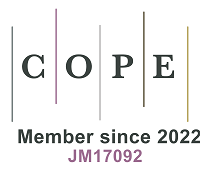REFERENCES
1. Buonanno G, Morawska L, Stabile L, Wang L, Giovinco G. A comparison of submicrometer particle dose between Australian and Italian people. Environ Pollut 2012;169:183-9.
2. Buonanno G, Stabile L, Morawska L. Personal exposure to ultrafine particles: the influence of time-activity patterns. Sci Total Environ 2014;468-469:903-7.
4. Manigrasso M, Natale C, Vitali M, Protano C, Avino P. Pedestrians in traffic environments: ultrafine particle respiratory doses. Int J Environ Res Public Health 2017;14:288.
5. Manigrasso M, Costabile F, Liberto LD, et al. Size resolved aerosol respiratory doses in a Mediterranean urban area: From PM10 to ultrafine particles. Environ Int 2020;141:105714.
6. Matson U. Indoor and outdoor concentrations of ultrafine particles in some Scandinavian rural and urban areas. Sci Total Environ 2005;343:169-76.
7. Querol X, Alastuey A, Ruiz C, et al. Speciation and origin of PM10 and PM2.5 in selected European cities. Atmospheric Environment 2004;38:6547-55.
8. Vu TV, Zauli-sajani S, Poluzzi V, Harrison RM. Factors controlling the lung dose of road traffic-generated sub-micrometre aerosols from outdoor to indoor environments. Air Qual Atmos Health 2018;11:615-25.
9. Baek JI, Ban YU. The Impacts of Urban Air Pollution Emission Density on Air Pollutant Concentration Based on a Panel Model. Sustainability 2020;12:8401.
10. Rivas I, Beddows DCS, Amato F, et al. Source apportionment of particle number size distribution in urban background and traffic stations in four European cities. Environ Int 2020;135:105345.
11. Rizza V, Stabile L, Buonanno G, Morawska L. Variability of airborne particle metrics in an urban area. Environ Pollut 2017;220(Pt A):625-35.
12. Kopanakis Ι, Chatoutsidou SE, Glytsos T, Lazaridis M. Impact from local sources and variability of fine particle number concentration in a coastal sub-urban site. Atmospheric Research 2018;213:136-48.
13. Chatain M, Alvarez R, Ustache A, Rivière E, Favez O, Pallares C. Simultaneous roadside and urban background measurements of submicron aerosol number concentration and size distribution (in the range 20-800 nm), along with chemical composition in strasbourg, france. Atmosphere 2021;12:71.
14. López-caravaca A, Castañer R, Clemente A, et al. The impact of intense winter Saharan dust events on PM and optical properties at urban sites in the southeast of the Iberian Peninsula. Atmosphere 2021;12:1469.
15. Rovelli S, Cattaneo A, Borghi F, et al. Mass Concentration and size-distribution of atmospheric particulate matter in an urban environment. Aerosol Air Qual Res 2017;17:1142-55.
16. Protano, Vitali, Avino. Nanoparticle behaviour in an urban street canyon at different heights and implications on indoor respiratory doses. Atmosphere 2019;10:772.
17. Moreno-ríos AL, Tejeda-benítez LP, Bustillo-lecompte CF. Sources, characteristics, toxicity, and control of ultrafine particles: an overview. Geoscience Frontiers 2022;13:101147.
18. Ohlwein S, Kappeler R, Kutlar Joss M, Künzli N, Hoffmann B. Health effects of ultrafine particles: a systematic literature review update of epidemiological evidence. Int J Public Health 2019;64:547-59.
20. Brown JS. Chapter 27-deposition of particles. Compar Bio Normal Lung (Second Edition) ;2015:513-36.
21. Zwozdziak A, Gini MI, Samek L, Rogula-kozlowska W, Sowka I, Eleftheriadis K. Implications of the aerosol size distribution modal structure of trace and major elements on human exposure, inhaled dose and relevance to the PM2.5 and PM10 metrics in a European pollution hotspot urban area. J Aeros Sci 2017;103:38-52.
22. Chalvatzaki E, Chatoutsidou S, Mammi-galani E, et al. Estimation of the personal deposited dose of particulate matter and particle-bound metals using data from selected European cities. Atmosphere 2018;9:248.
23. Manojkumar N, Srimuruganandam B. Age-specific and seasonal deposition of outdoor and indoor particulate matter in human respiratory tract. Atmosph Poll Res 2022;13:101298.
24. Chalvatzaki E, Chatoutsidou SE, Kopanakis I, et al. Personal deposited dose and its influencing factors at several Greek sites: an analysis in respect to seasonal and diurnal variations. Environ Sci Pollut Res Int 2021;28:29276-86.
25. Gini M, Manousakas M, Karydas AG, Eleftheriadis K. Mass size distributions, composition and dose estimates of particulate matter in Saharan dust outbreaks. Environ Pollut 2022;298:118768.
26. Chatoutsidou SE, Kopanakis I, Lagouvardos K, Mihalopoulos N, Tørseth K, Lazaridis M. PM10 levels at urban, suburban, and background locations in the eastern Mediterranean: local versus regional sources with emphasis on African dust. Air Qual Atmos Health 2019;12:1359-71.
27. Chalvatzaki E, Lazaridis M. Development and application of a dosimetry model (ExDoM2) for calculating internal dose of specific particle-bound metals in the human body. Inhal Toxicol 2015;27:308-20.
28. Human respiratory tract model for radiological protection. A report of a Task Group of the International Commission on Radiological Protection. Ann ICRP 1994;24:1-482.
29. Paquet F, Etherington G, Bailey MR, et al. ICRP. ICRP publication 130: occupational intakes of radionuclides: part 1. Ann ICRP 2015;44:5-188.
30. Pant P, Harrison RM. Estimation of the contribution of road traffic emissions to particulate matter concentrations from field measurements: a review. Atmospheric Environment 2013;77:78-97.
31. Rodríguez S, Van Dingenen R, Putaud J, et al. A study on the relationship between mass concentrations, chemistry and number size distribution of urban fine aerosols in Milan, Barcelona and London. Atmos Chem Phys 2007;7:2217-32.
32. Aalto P, Hämeri K, Paatero P, et al. Aerosol particle number concentration measurements in five European cities using TSI-3022 condensation particle counter over a three-year period during health effects of air pollution on susceptible subpopulations. J Air Waste Manag Assoc 2005;55:1064-76.
33. Voliotis A, Samara C. Submicron particle number doses in the human respiratory tract: implications for urban traffic and background environments. Environ Sci Pollut Res Int 2018;25:3372435.
34. Hussein T, Löndahl J, Paasonen P, et al. Modeling regional deposited dose of submicron aerosol particles. Sci Total Environ 2013;458-460:140-9.
35. Xing YF, Xu YH, Shi MH, Lian YX. The impact of PM2.5 on the human respiratory system. J Thorac Dis 2016;8:E69-74.
36. Hussain M, Pierre M. Lung deposition predictions of airborne particles and the emergence of contemporary diseases Part-I. the Health 2011;2:51. Available from: https://biophysics.sbg.ac.at/paper/thehealth [Last accessed on 10 Jun 2022].
37. Chalvatzaki E, Lazaridis M. Α dosimetry model of hygroscopic particle growth in the human respiratory tract. Air Qual Atmos Health 2018;11:471-82.
38. Patterson R. , Zhang Q, Zheng M, Zhu Y. Particle deposition in respiratory tracts of school-aged children. Aerosol Air Qual Res 2014;14:64-73.
39. Daigle CC, Chalupa DC, Gibb FR, et al. Ultrafine particle deposition in humans during rest and exercise. Inhal Toxicol 2003;15:539-52.
40. Hussein T, Boor BE, Löndahl J. Regional inhaled deposited dose of indoor combustion-generated aerosols in Jordanian urban homes. Atmosphere 2020;11:1150.
41. Oravisjärvi K, Pietikäinen M, Ruuskanen J, Rautio A, Voutilainen A, Keiski RL. Effects of physical activity on the deposition of traffic-related particles into the human lungs in silico. Sci Total Environ 2011;409:4511-8.
43. Hussein T, Saleh S, dos Santos V, Boor B, Koivisto A, Löndahl J. Regional inhaled deposited dose of urban aerosols in an eastern mediterranean city. Atmosphere 2019;10:530.
44. Buonanno G, Giovinco G, Morawska L, Stabile L. Tracheobronchial and alveolar dose of submicrometer particles for different population age groups in Italy. Atmospheric Environment 2011;45:6216-24.
45. Tomasi C, Fuzzi S, Kokhanovsky A. Atmospheric aerosols: Life cycles and effects on air quality and climate. Wiley-VCH. Verlag Gmbh & Co. KGaA, Boschstr. 12, 64469 Weinheim, Germany; 2017, pp704. Available from: https://books.google.com.hk/books?hl=zh-CN&lr=&id=5bCGDQAAQBAJ&oi=fnd&pg=PR15&dq=Tomasi+C,+Fuzzi+S,+Kokhanovsky+A.+Atmospheric+aerosols:+Life+cycles+and+effects+on+air+quality+and+climate.+Wiley-VCH.+Verlag+Gmbh+%26+Co.+KGaA,+Boschstr.+12,+64469+Weinheim,+Germany%3B+2017,+pp704.&ots=SahqgPxYSZ&sig=2FnOVk9HNYNrNQuSmkyRuZVuaJA&redir_esc=y#v=onepage&q&f=false [Last accessed on 10 Jun 2022].
46. Thompson JE. Airborne particulate matter: human exposure and health effects. J Occup Environ Med 2018;60:392-423.
47. Vicente ED, Alves CA, Martins V, Almeida SM, Lazaridis M. Lung-deposited dose of particulate matter from residential exposure to smoke from wood burning. Environ Sci Pollut Res Int 2021;28:65385-98.







